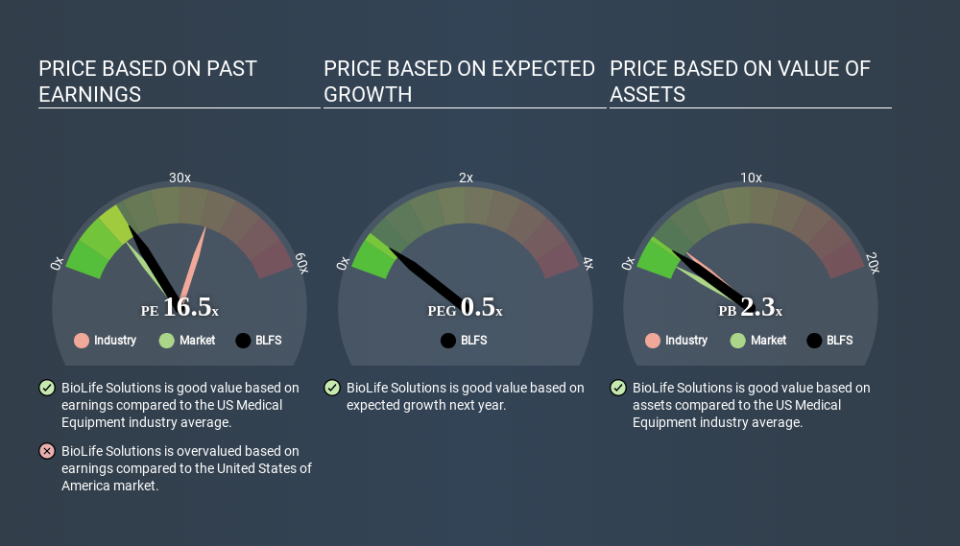How Does BioLife Solutions's (NASDAQ:BLFS) P/E Compare To Its Industry, After The Share Price Drop?

Unfortunately for some shareholders, the BioLife Solutions (NASDAQ:BLFS) share price has dived 36% in the last thirty days. That drop has capped off a tough year for shareholders, with the share price down 48% in that time.
All else being equal, a share price drop should make a stock more attractive to potential investors. While the market sentiment towards a stock is very changeable, in the long run, the share price will tend to move in the same direction as earnings per share. The implication here is that long term investors have an opportunity when expectations of a company are too low. One way to gauge market expectations of a stock is to look at its Price to Earnings Ratio (PE Ratio). Investors have optimistic expectations of companies with higher P/E ratios, compared to companies with lower P/E ratios.
View our latest analysis for BioLife Solutions
How Does BioLife Solutions's P/E Ratio Compare To Its Peers?
BioLife Solutions's P/E of 16.52 indicates relatively low sentiment towards the stock. The image below shows that BioLife Solutions has a lower P/E than the average (37.7) P/E for companies in the medical equipment industry.
BioLife Solutions's P/E tells us that market participants think it will not fare as well as its peers in the same industry. While current expectations are low, the stock could be undervalued if the situation is better than the market assumes. You should delve deeper. I like to check if company insiders have been buying or selling.
How Growth Rates Impact P/E Ratios
Earnings growth rates have a big influence on P/E ratios. Earnings growth means that in the future the 'E' will be higher. And in that case, the P/E ratio itself will drop rather quickly. So while a stock may look expensive based on past earnings, it could be cheap based on future earnings.
BioLife Solutions's earnings made like a rocket, taking off 216% last year.
Remember: P/E Ratios Don't Consider The Balance Sheet
Don't forget that the P/E ratio considers market capitalization. So it won't reflect the advantage of cash, or disadvantage of debt. Hypothetically, a company could reduce its future P/E ratio by spending its cash (or taking on debt) to achieve higher earnings.
While growth expenditure doesn't always pay off, the point is that it is a good option to have; but one that the P/E ratio ignores.
Is Debt Impacting BioLife Solutions's P/E?
The extra options and safety that comes with BioLife Solutions's US$8.0m net cash position means that it deserves a higher P/E than it would if it had a lot of net debt.
The Verdict On BioLife Solutions's P/E Ratio
BioLife Solutions's P/E is 16.5 which is above average (13.0) in its market. Its net cash position is the cherry on top of its superb EPS growth. So based on this analysis we'd expect BioLife Solutions to have a high P/E ratio. Given BioLife Solutions's P/E ratio has declined from 25.7 to 16.5 in the last month, we know for sure that the market is significantly less confident about the business today, than it was back then. For those who prefer to invest with the flow of momentum, that might be a bad sign, but for a contrarian, it may signal opportunity.
Investors have an opportunity when market expectations about a stock are wrong. If the reality for a company is better than it expects, you can make money by buying and holding for the long term. So this free visual report on analyst forecasts could hold the key to an excellent investment decision.
But note: BioLife Solutions may not be the best stock to buy. So take a peek at this free list of interesting companies with strong recent earnings growth (and a P/E ratio below 20).
If you spot an error that warrants correction, please contact the editor at editorial-team@simplywallst.com. This article by Simply Wall St is general in nature. It does not constitute a recommendation to buy or sell any stock, and does not take account of your objectives, or your financial situation. Simply Wall St has no position in the stocks mentioned.
We aim to bring you long-term focused research analysis driven by fundamental data. Note that our analysis may not factor in the latest price-sensitive company announcements or qualitative material. Thank you for reading.

